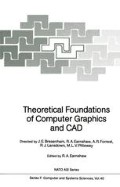Abstract
In the first part of this paper, I review the recent efforts on integrating robotics and computer science ideas. Specifically, I advocate the view that applying results from areas of computer science such as concrete complexity, symbolic computation, and computational geometry will simplify the work of robot programmers. There is now a wealth of very interesting results and I only cover a small portion of it.
In the second part, the discussion takes place in the context of model-based robotics. I argue that time has come to build a “Geometer’s Workbench,” a system integrating geometric knowhow with algorithm animation techniques and interactive graphics to visualize complex situations as encountered in robotics. Such a system is expected to broaden the way geometry is practiced in the style Macsyma† has accomplished for algebra.
Preview
Unable to display preview. Download preview PDF.
References
V. Akman, “Shortest paths avoiding polyhedral obstacles in 3-dimensional Euclidean space,” Rep. IPL-TR-075, Image Processing Lab, Rensselaer Polytechnic Inst., Troy, New York (June 1985). (also: PhD thesis, Electrical, Computer, and Systems Eng. Dept.; Springer-Verlag, LNCS Series, to appear.)
B.G. Baumgart, “GEOMED: Geometric editor,” Rep. STAN-CS-74-414, Computer Science Dept., Stanford Univ., Stanford, Calif. (May 1974).
E.A. Bier and M.C. Stone, “Snap-dragging,” ACM SIGGRAPH’86 Proc., Dallas, Texas, pp. 233–240 (Aug. 1986).
M.H. Brown and R. Sedgewick, “Techniques for algorithm animation,” IEEE Software 2(1), pp. 28–39 (Jan. 1985).
C.E. Buckley, “The application of continuum methods to path planning,” AI Tech. Rep. No. 48, Schlumberger Palo Alto Research (Aug. 1985). (also: PhD thesis, Dept. of Mechanical Eng., Stanford Univ.)
L.P. Chew, “There is planar graph almost as good as the complete graph,” Proc. Second Annual ACM Symp. Computational Geometry ,Yorktown Heights, New York, pp. 169–177 (June 1986).
W. Cunningham, “The construction of Smalltalk-80 applications,” Manuscript, Computer Research Lab, Tektronix, Inc., Beaverton, Oregon (Nov. 1985).
H. Edelsbrunner, M.H. Overmars, and R. Seidel, “Some methods of computational geometry applied to computer graphics,” Computer Vision, Graph., and Image Proc. 28, pp. 92–108 (1984).
I. Fogg and P. Eades, “GED -A graphics editor for computational geometers,” Rep. No. 68, Computer Science Dept., Univ. of Queensland, Australia (May 1986).
A.R. Forrest, “Computational geometry in practice,” pp. 707–724 in Fundamental Algorithms for Computer Graphics ,ed. R.A. Earnshaw, Springer-Verlag, Berlin (1985).
W.R. Franklin and V. Akman, “Euclidean shortest paths in 3-space, Voronoi diagrams with barriers, and related complexity and algebraic issues,” pp. 895–917 in Fundamental Algorithms for Computer Graphics ,ed. R.A. Earnshaw, Springer-Verlag (1985).
W.R. Franklin and V. Akman, “Partitioning the space to calculate shortest paths to any goal around polyhedral obstacles,” Proc. Instrument Soc. of America Workshop on Robotics and Expert Sys. ,pp. 45–52 (June 1985).
W.R. Franklin, V. Akman, and C. Verrilli, “Voronoi diagrams with barriers and on polyhedra for minimal path planning,” Visual Computer 1, pp. 133–150(1985).
W.R. Franklin, P.Y.F. Wu, S. Samaddar, and M. Nichols, “Prolog and geometry projects,” IEEE Computer Graph. and Applic. 6(11), pp. 46–55 (Nov. 1986).
W.R. Franklin and V. Akman, “Locus techniques for shortest path problems in robotics,” Proc. IFAC Symp. Robot Control (SYROCO’85) ,Pergamon Press (1986).
A. Goldberg, Smalltalk-80, The Interactive Programming Environment ,Addison-Wesley, Reading, Mass. (1984).
J.E. Hopcroft and G.T. Wilfong, “Reducing multiple object motion planning to graph searching,” SIAM J. Computing 15(3), pp. 768–785 (Aug. 1986).
J.E. Hopcroft and G. Wilfong, “Motion of objects in contact,” Int’l J. Robotics Research 4(4), pp. 32–46 (Winter 1986).
J. van Leeuwen, “Graphics and computational geometry,” Tech. Rep. RUU-CS-81-18, Computer Science Dept, Univ. of Utrecht, Netherlands (Dec. 1981).
J.S.B. Mitchell, “Planning shortest paths,” Rep. No. 561 (AI Series No. 1), Hughes Aircraft Co. Research Labs (Aug. 1986). (also: PhD thesis, Operations Research Dept., Stanford Univ.)
C.H. Papadimitriou, “An algorithm for shortest-path motion in three dimensions,” Info. Proc. Letters 20(5), pp. 259–263 (June 1985).
R. Pavelle, “MACSYMA: Capabilities and applications to problems in engineering and sciences,” pp. 1–61 in Applications of Computer Algebra ,ed. R. Pavelle, Kluwer Academic Publ., Boston (1985).
A.P. Pentland, “Perceptual organization and the representation of natural form,” Rep. TN-357, AI Center, SRI Int’l, Menlo Park, Calif. (July 1985).
A.P. Pentland, “SUPERSKETCH™,” User manual, AI Center, SRI Int’l, Menlo Park, Calif. (Dec. 1985).
J.H. Reif and J.A. Storer, “Shortest paths in Euclidean space with polyhedral obstacles,” Tech. Rep. CS-85-121, Computer Science Dept., Brandeis Univ., Waltham, Mass. (April 1985).
J.H. Reif and M. Sharir, “Motion planning in the presence of moving obstacles,” Proc. 26th Annual IEEE Symp. Foundations of Computer Science ,pp. 144–154 (1985).
J.T. Schwartz and M. Sharir, “Motion planning and related geometric algorithms in robotics,” Manuscript, Courant Inst. of Math. Sciences, New York Univ. (1986).
M. Sharir and A. Baltsan, “On shortest paths amidst convex polyhedra,” Proc. Second Annual ACM Symp. Computational Geometry ,Yorktown Heights, New York, pp. 193–206 (June 1986).
M. Sharir and A. Schorr, “On shortest paths in polyhedral spaces,” SIAM J. Computing 15(1), pp. 193–215 (Feb. 1986).
T.L. Williams, “A graphical interface to an Economist’s Workstation,” IEEE Computer Graph. and Applic. 4(8), pp. 42–47 (Aug. 1984).
Author information
Authors and Affiliations
Editor information
Editors and Affiliations
Rights and permissions
Copyright information
© 1988 Springer-Verlag Berlin Heidelberg
About this paper
Cite this paper
Akman, V. (1988). Geometry and Graphics Applied to Robotics. In: Earnshaw, R.A. (eds) Theoretical Foundations of Computer Graphics and CAD. NATO ASI Series, vol 40. Springer, Berlin, Heidelberg. https://doi.org/10.1007/978-3-642-83539-1_23
Download citation
DOI: https://doi.org/10.1007/978-3-642-83539-1_23
Publisher Name: Springer, Berlin, Heidelberg
Print ISBN: 978-3-642-83541-4
Online ISBN: 978-3-642-83539-1
eBook Packages: Springer Book Archive

